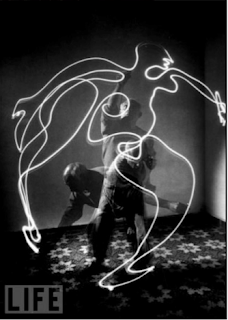Pablo Picasso is the artist that created this piece. He is a famous Spanish painter, who is a well known co-founder in the Cubist movement in the early 1900’s. Before he started painting with his light pen Picasso was creating images with a paintbrush and oil paints; producing works like these:
Picasso is an interesting person to analyse as he has proven himself in many areas of art, painting, sculpturing and photography, to name a few. Along side his other work you can see the diversity and breadth of his range of skill.
The image is a photograph taken around 1949. The image was part of a collection of images that Picasso created; Picasso Draws a Centaur is the most famous of the group of light paintings. There were many artists working in this style at this time, such as Man Ray, Frank Gilbreth and Gjon Mili, who introduced Picasso to the art form.
In the image you are given a sense of movement, as Picasso has been captured in several positions as he is ‘painting.’ Unlike other forms of photography and paintings in this image you can see what has happened to produce the image produced; rather than a series of images leading to the final outcome, this one picture has captured it all.
The photo is in black and white. The image drawn has no straight lines and few sharp corners; the lines are curved and are produced in one fluid motion, therefore the impression given of motion and life. The transparency of Picasso himself also gives the photo life and motion.
Picasso would have had to prepare and plan a certain movement path so that the rough outline of the person is visible and interpretable; he would also have to work out how long he had as a result of the delay of the shutter opening and closing is, to ensure that he has drawn the image in that period given.
This piece reminds me of my dad’s drawings, the irregular proportions of the body and the freedom of the pen with fluid motions. The fact that there is an irregular shape to the subject gives it a sense of freedom and reading deeper into you could interpret free will of the person unrestricted by the usual image, free to make their own decisions- Picasso was unrestrained in drawing the person this way. The image is unique as is every person.
 Personally I like this piece by Picasso, though it is not my favourite light painting; some are more elaborate and intricate, but Picasso did not have the technology that these images have. I enjoy the fact that you can see him drawing the painting, and that he is blurred and also that due to the slow shutter speed, it makes several versions of him appear - I think that this is quite effective, and allows you to guess and understand the process in which the image was produced. Because the slow shutter speed allowed Picasso to be capture in movement and is partially translucent it adds a ‘ghostly’ feel and gives the image an intriguing atmosphere and impression- the image gains life.
Personally I like this piece by Picasso, though it is not my favourite light painting; some are more elaborate and intricate, but Picasso did not have the technology that these images have. I enjoy the fact that you can see him drawing the painting, and that he is blurred and also that due to the slow shutter speed, it makes several versions of him appear - I think that this is quite effective, and allows you to guess and understand the process in which the image was produced. Because the slow shutter speed allowed Picasso to be capture in movement and is partially translucent it adds a ‘ghostly’ feel and gives the image an intriguing atmosphere and impression- the image gains life.This photograph fits into the category of Portraiture as well as Abstract, as the artist is best known for his Abstract paintings and work in general. Picasso’s work has always struck me as impressionistic and the audience can decide on what they see- the base of the image may be the same (e.g. a person) but the way on which the subject is perceived will be different- is it about freewill and freedom or about overcoming discrimination about the way and who you are. Picasso’s work is can look like more than one thing, depending on their age, gender or even at what point in time that they look at it people will interpret different things.
What do you think the artist is trying to say or represent? Again I think that this is open to interpretation; Picasso could simply be experimenting with a new form of art in which he was introduced to by a fellow artist and was intrigued to try it and or expand his repertoire; or something else entirely
What do you think the artist is trying to say or represent?


No comments:
Post a Comment